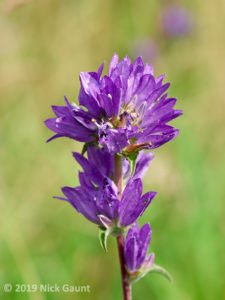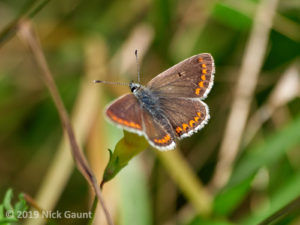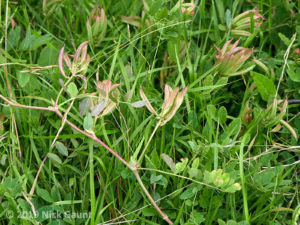August is a busy month for holidays, so just 9 members gathered to spend Yorkshire Day ‘botanizing at Brockadale’. Brockadale is a Yorkshire Wildlife Trust nature reserve in West Yorkshire. It lies 10 miles north of Doncaster, just east of the A1, between the villages of Wentbridge and the Smeatons. The name derives from ‘broken dale’, referring to the numerous craggy outcrops of Magnesian limestone along this section of the valley of the River Went. Here the river meanders along the valley, edged either by carr-type woodlands, cliffs, or alluvial meadows. The steepness of the valley sides has prevented any cultivation and the slopes are still covered by undisturbed species rich Magnesian Limestone grasslands or ancient woodland.
Muff Upsall and Richard Campbell planned a route for us as, thankfully, these 2 members had visited this extensive reserve previously. However, as per normal, exploring the car park area kept us busy for at least the first 45 minutes. Easy to spot were the numerous tall blue spikes of Clustered Bellflower, scattered in the meadow alongside. We then lost time puzzling over a single, enchanting seed head, which Muff later identified as the seed head for Dropwort. We set off, exploring different habitats along the way, usually in single file and having to relay information along our line. The patches of purples, blues and yellows that stood out often proved to be patches of Greater and Lesser Knapweed, Wild Basil, Betony, Field and Small Scabious, Lady’s Bedstraw, Agrimony and the lovely, creamy coloured Wild Mignonette dotted in between. A sunny lunchtime was spent enjoying the view across the slightly damp, alluvial meadow. We all heard the green woodpecker in the nearby willows, but only Richard spotted the kingfisher fly up the river.
In the afternoon we began to explore part of the woodland. At first, at each side dense, tall clumps of Tor-grass, or Chalk False-Brome, were definitely decreasing the plant diversity. Within the shadier wood it was enjoyable to see Old Man’s Beard in full flower and clambering to seek out sunlit spots. Stinking Hellebore was found, and then, catching the light, an old, brown, dried plant of Common Gromwell with a very shiny, very white seed in each stem leaf axil.
Emerging from the wood we rejoined Jack and Erin who had spent the morning adventuring. They were already enjoying the most wonderful wide open meadow that we will all remember as memorable for the abundance of butterflies. Erin compiled a list of butterflies seen as follows; Large White, Small White, Painted Lady, Peacock, Small Tortoiseshell, Brimstone, Brown Argus, Red Admiral, Gatekeeper, Small Skipper, Comma, 6-Spot Burnet, and 2 members enjoyed a brief sighting of a Silver-washed Fritillary. This last sighting was unexpected as Brockadale is a known location for the Dark Green Fritillary but we were unlucky that day. Just before leaving this meadow Richard pointed out a Liquorice plant, a plant that was new to most of us. The flowers had finished but large seed pods were developing like chunky pea pods.
The trip was a most enjoyable way to mark Yorkshire Day. A plant list is attached.
Many thanks to Muff for organizing the day, and to Nick for taking the stunning photos.
Kerry Morrison




